Help
© TicketCo AS 2025.
Legal terms for ticket buyers.
Legal terms for organizers.

Visningsformat: DCP
Regissør: Katsuhiro Otomo
Manusforfattere: Katsuhiro Otomo, Izo Hashimoto
Skuespillere: Mitsuo Iwata, Nozomu Sasaki, Mami Koyama
Produksjonsland: Japan
Språk: Japansk
Undertekst: Engelsk
Lengde: 2 time & 4 minutter
Akira (1988) trenger muligens ingen introduksjon. Denne banebrytende japanske anime-filmen er å regne blant historiens mest innflytelsesrike. Dersom du aldri har sett Akira tidligere, vil du nok kunne kjenne igjen flere visuelle motiver. Mest kjent er den ikoniske sykkelen og dens svingninger, som har vært et referansepunkt i alt fra Batman: The Animated Series (1993) og Pokémon-serien til Nope (2022) av Jordan Peele. Filmen er satt i en post-apokalyptisk Neo Tokyo – bygget på restene av tidligere Tokyo – hvor vi finner ulike motorsykkelbander i konstant konfrontasjon med hverandre. Bybildet er styrt og formet av overveldende korrupsjon og vold, og de autoritære styresmaktene utsetter befolkningen for enorme overskridelser. Midt i alt dette finnes det også skikkelser med tilsynelatende overnaturlige evner, som potensielt kan ødelegge hele verden.
Akira kombinerer et komplekst og dypt filosofisk narrativ med visuelle effekter som var revolusjonerende for sin tid og som sammen med Ghost in the Shell (1995) av Mamoru Oshii står som hjørnesteiner i animesjangerens historie. Dette er en film som aldri har sluttet å være relevant, både for filmkunsten, estetisk innovasjon og ikke minst samfunnsmessige og politiske lesninger. Når vi ser utviklingen av høyreradikale miljøer og politiske styresmakter i store deler av verden og ikke minst den totalt destruktive konsekvensen av menneskeskapt klimakrise, er det kanskje noe å hente fra Akira og regissør Katsuhiro Otomo. Hele veien utforsker filmen makt, kontroll og de etiske grensene ved vitenskap og teknologi. Tenkere som Kohei Saito har satt konsepter som vekstkritisk kapitalisme og økososialisme på dagsorden igjen, blant annet med Marx in the Anthropocen: Towards the Idea of Degrowth Communism (2023), og Akira står i tett samtale med disse idéene.
Akira (1988) is a movie that likely needs no introduction. It is widely regarded as one of the most influential anime films in history. If you have never watched Akira before, you will likely still recognize several of its visual motifs, such as the iconic motorcycle slide, which has served as a reference point in everything from Batman: The Animated Series (1993) and the Pokémon series, to Jordan Peele’s Nope (2022). The film is set in a post-apocalyptic Neo-Tokyo—built upon the ruins of Tokyo—where rival biker gangs clash regularly, while the cityscape is ruled and shaped by extreme corruption and violence. The authoritarian government commits vast abuses against its population, and amidst all of this, there are people who seem to possess almost supernatural powers that may hold the potential to destroy the world.
Akira combines a complex and deeply philosophical narrative with visual effects that were revolutionary for their time. Alongside Ghost in the Shell (1995) by Mamoru Oshii, it stands as a cornerstone in the history of its genre. It is a film that has never ceased to be relevant—for cinema, for aesthetic innovation, and not least, for social and political interpretations. As we bear witness to the rise of far-right movements and authoritarian regimes in many parts of the world—not to mention the utterly destructive consequences of human-made climate catastrophes—it may be worth revisiting Katsuhiro Otomo’s Akira. Throughout, the film explores power, control, and the ethical boundaries of science and technology—or the lack thereof. Concepts like degrowth capitalism and ecosocialism have been brought into the public consciousness again, largely through works such as Marx in the Anthropocene: Towards the Idea of Degrowth Communism (2023) by Kohei Saito. For those passionate or concerned about such issues, there’s likely a lot to be drawn from Akira.